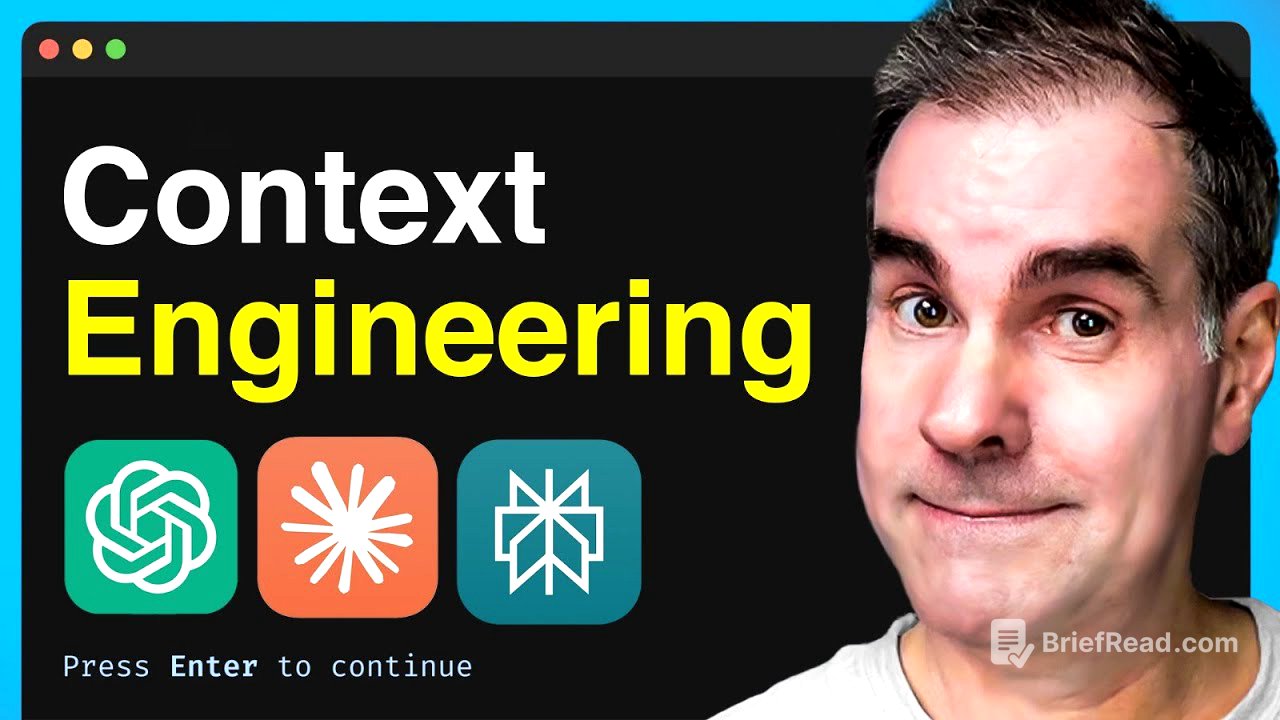TLDR;
This video introduces context engineering as a crucial skill for leveraging AI in business, emphasizing its dynamic nature and integration into workflows. It differentiates context engineering from traditional prompt engineering, highlighting the importance of relevant, efficient, accessible, and logical (REAL) context. The video also touches on the significance of structuring knowledge files and the limitations of context engineering in solving all AI-related issues, while also pointing towards advanced concepts like context evolution and creating learning systems.
- Context engineering involves dynamic, workflow-integrated AI.
- It's more than just providing context in prompts; it's about the overall environment.
- Key is providing the right amount of context: Relevant, Efficient, Accessible, Logical (REAL).
What is Context Engineering? [0:55]
Context engineering is presented as a vital skill for staying ahead in the AI landscape and creating an AI-first business. It's more than just giving AI prompts the right context; it involves implementing this understanding into workflows. By doing so, businesses can gain a significant advantage in utilizing AI effectively.
Traditional Prompt Formatting vs. Context Engineering [0:55]
Traditional prompt formatting includes a static context section, such as defining the target audience or writing style. Context engineering differs in two primary ways: it uses dynamic context by connecting prompts to dynamic knowledge bases (like Google Sheets or Docs) or tools (like ConvertKit or HubSpot) via APIs or MCP connections. It also pertains to workflows containing AI, such as AI agents, where each step connects to a tool or knowledge file, using the output from the previous step if applicable.
Dynamic Context & Workflow Integration [1:59]
Context engineering involves creating an overall environment for AI to operate within a workflow to achieve specific business goals. The aim is to produce high-quality outputs from the AI workflow by providing the right amount of context at the right time. This approach focuses on building an environment where AI can effectively function.
Context Engineering vs. Prompt Engineering with examples [2:34]
Prompt engineering is a subset of context engineering, involving giving instructions to AI within the broader environment or workflow. Understanding the kind of context to provide is key to getting the best outputs. For example, a simple prompt to write a sales follow-up email lacks depth and contextual relevance. Context engineering, on the other hand, builds a workflow where AI can access prospect's company information, previous interactions, pain points, and CRM data to craft a personalized email.
Building Contextual Workflows (Relay.app Example) [4:10]
The video uses relay.app as an example of building contextual workflows. A workflow can be triggered by a specific tag in an email CRM, with the next step involving AI, such as using Claude signup 4 for writing. The prompt includes instructions to create personalized outreach using specific context elements. The magic comes from including data from previous steps, connecting to dynamically updated apps, and attaching knowledge files like Google Docs or Sheets.
Connecting Tools & Dynamic Knowledge Bases [6:22]
Context engineering involves building AI workflows with AI agents that require proper context to be effective. Tools like Claude allow connecting to other tools via MCPS and desktop extensions, such as using Air Table to write emails with relevant context. Building AI workflows in tools like relay.app, MindPal, or N8N is the best way to leverage context engineering.
How Much Context is Enough? Too Much vs. Too Little Context [7:41]
Providing too much context means giving the AI an excessive amount of irrelevant or redundant information, leading to higher costs, difficulty in finding relevant information, and increased hallucinations. For example, feeding a 50-page business plan to AI for drafting a short social media post is too much context. Too little context results in AI lacking necessary information, leading to generic answers, hallucinations, and a lack of personalization.
The REAL Framework for Context (Relevant, Efficient, Accessible, Logical) [9:41]
The right amount of context can be determined using the acronym REAL: Relevant (including only directly relevant information), Efficient (providing information concisely without redundancy), Accessible (making context readily available to the AI), and Logical (structuring information for easy understanding and processing).
Structuring Knowledge Files for AI [11:32]
Structuring knowledge files appropriately is crucial, ensuring they are organized in a way that makes it easy for the AI to understand. This involves using clear formats, consistent terminology, and well-defined knowledge bases. If unsure how to structure knowledge, one can ask AI tools like ChatGBT for guidance.
Will Context Engineering Solve Everything? [12:22]
Context engineering will not solve all AI-related issues like hallucinations due to the nature of how LLMs work. Poorly worded prompt instructions can also lead to misinterpretations. However, it minimizes hallucinations by providing controlled and relevant information, especially when combined with specific prompting, grounding the AI in real data.
Advanced Ideas [13:21]
Advanced concepts within context engineering include context evolution throughout workflows, where context gets smarter and more specific with each step. Another idea is creating a learning system where the workflow improves context over time by remembering what worked from prior runs and automatically improving its context decisions based on feedback.








